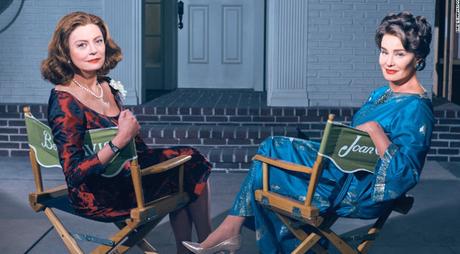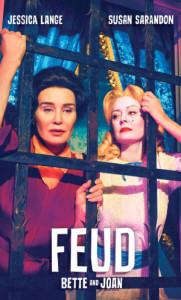
Ryan Murphy, an anthology specialist (yes, we're talking about American Horror Story and American Crime Story), further expands his repertoire to another real life shenanigan, peeling legendary feud - a clash of titan - in his new series, Feud. Digging up classic feud between two classic Hollywood stars, Bette Davis and Joan Crawford during the production of psycho-biddy What Ever Happened to Baby Jane?, Murphy has reserved two award seats for his stars, Susan Sarandon and Jessica Lange.
Sarandon and Lange respectively portray Davis and Crawford remarkably, in the sense that the feud pervades to the present-time stars. The heat of the conflicts has ingrained so profoundly that we might see Sarandon as a manifestation of Bette Davis and Lange as Joan Crawford.
Joan Crawford, in the twilight of her career, had faded into unused actress due to Hollywood's misogynistic sentiment towards women. She sought for a prominent comeback when receiving a script for What Ever Happened to Baby Jane?, which she predicted would work with involvement of another fading star, Bette Davis, an Oscar darling the size of Meryl Streep back then. While both were stars of the same generation, they had to put aside their stardom rivalries; because if the truce failed, it might mean a perfect woe for director Robert Aldrich (Alfred Molina) and producer, Jack Warner (Stanley Tucci).
Feud knows how to orchestrate this real feud into a sympathetic drama - without being overdramatizing the source story. In presenting the story authentically without biased to certain character, Feud has this approach - semi-docu-style, which highlights on how the feud was and had affected both stars. This show knows exactly that the center of this feud isn't merely fame or respect or acknowledgement, but rather the pains each figure bears - the pain that has made them who they were and the pain that they brought along their fame.
Murphy has extra benefits from both stars to portray Davis and Crawford. Both Sarandon and Lange have gone past their time, too, although the industry has grown up now; therefore, the whole performance delivered by both actresses felt vivid and relevant. Crawford incarnates through Lange, reminiscing a remnant of the most beautiful actress Hollywood ever had. Crawford used to be beautiful; people adored her for beauty. Yet, that backlashed when people started accusing her for being famous mainly because she's beautiful and 'not so talented.' Crawford is the 'bigger' star on this feud - she's the light and salt of the conflict in a good way and in the worst way. On the opposite side, Davis comes to existence via Sarandon's more purposeful performance. Davis wasn't as beautiful as Crawford, but she's all talent. She knows how to deal with fame and is more calculated about that.
As a viewer, we might learn that Davis and Crawford were actually completing each other; they are so same yet so different. And, the show has found its way to get audiences sympathizing to each character respectively. You might root to one character, but on the other occasion, you might think otherwise. And, as you might imagine, watching What Ever Happened to Baby Jane? helps you to find out that that whole film is actually a reflection of Davis and Crawford's problem.
There's an exchanging dialogue in episode 7 to reflect the whole difference which made both characters who they projected to be. Out of conflict, Davis asks Crawford the question, "How did it feel to be the most beautiful girl in the world?" as Crawford replies, "it was wonderful. The most joyous thing you could ever imagine. And it was never enough." In response, Crawford also ask the same question, substituting "beautiful" with "talented", to which Davis answers with exactly the same question. Yet, there's this dialogue from the ending of What Ever Happened to Baby Jane? to actually wrap the whole thing, stating, "'You mean all this time we could have been friends?" - which also becomes the title of the finale.
Feud also works effectively with supporting characters, which often steal our sympathy, because of what they experience in accordance to Davis and Crawford's conflict. Most notable supporting character is Alfred Molina's Robert Aldrich, a struggling middle-aged director, who mostly became the scapegoat and direct victim of the feud. On the contrary, a tabloid journalist, Hedda Hopper (Judy Davis) is the one who got most benefits from the feud as she sided with each party who's willing to give her best-selling stories. On Crawford's side, there's a story about her and her assistant, Mamacita (Jackie Hoffman) - the only sane woman in this story; while on Davis' side, there's a side-feud between the actress and her daughter, B.D. (Kiernan Shipka). There are also brief appearances of Murphy's favorites, Kathy Bates and Sarah Paulson; but, the most delightful among them is the recurring performance of Catherine Zeta-Jones. However, those supporting roles are only as good as the stake of the main conflict that dragged them inside. At the core, only Davis and Crawford matter to the whole story.
Despite being harsh and 'difficult to watch', Feud spreads awe and sympathetic performances in every episode to get audiences glued to that till-death-do-us-apart feud. And, with second season locked for feud between Prince Arthur and Princess Diana, we cannot wait any longer for what kind of excitement Ryan Murphy will be bringing along.
Feud: Bette and Joan (2017)


Drama, Biography Created by: Ryan Murphy , Jaffe Cohen , Michael Zam Starred by: Jessica Lange, Susan Sarandon, Judy Davis, Alfred Molina Network: FX No. of Episodes: 8 Runtime: 42 mins (finale - 59 mins)
